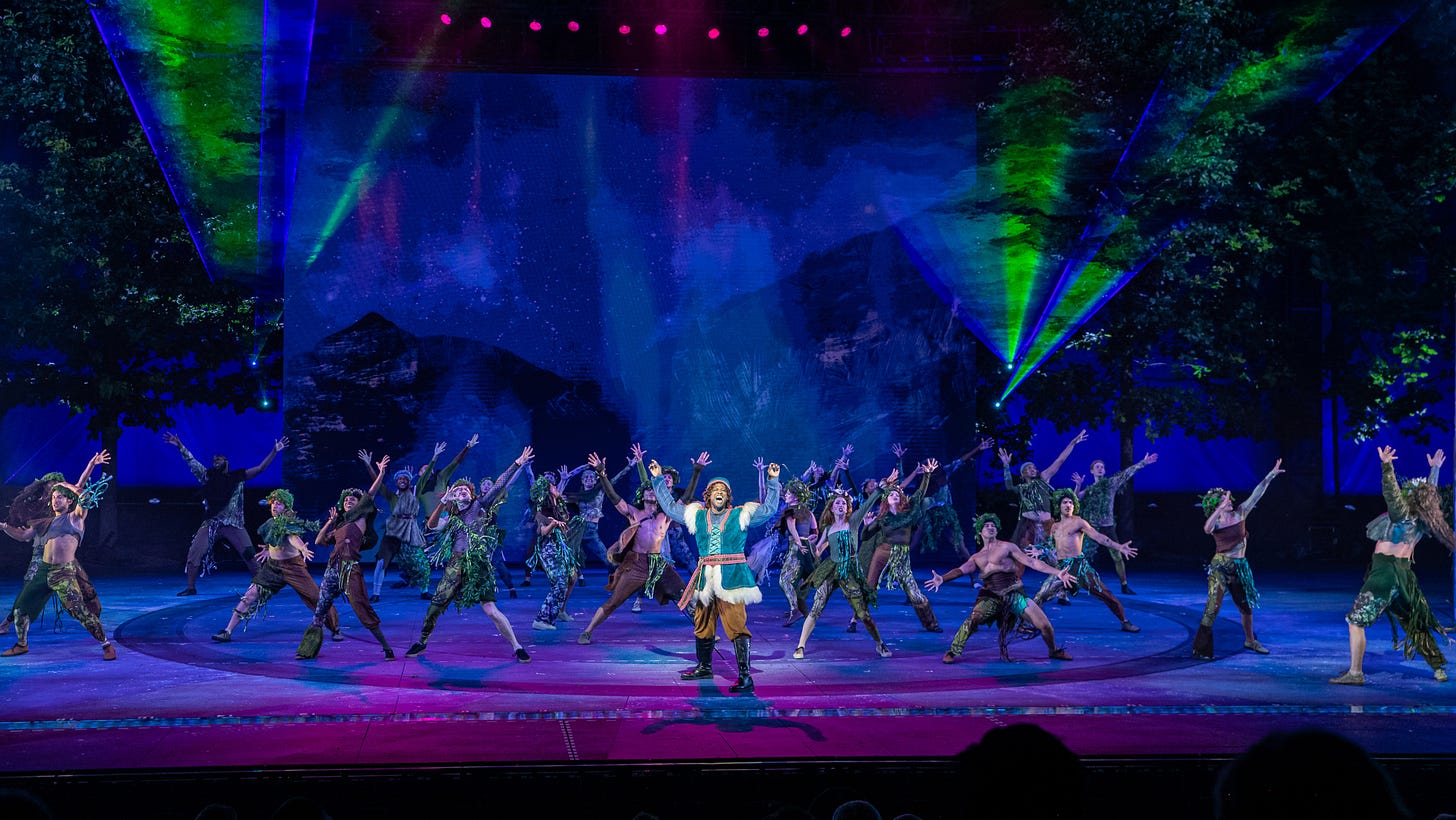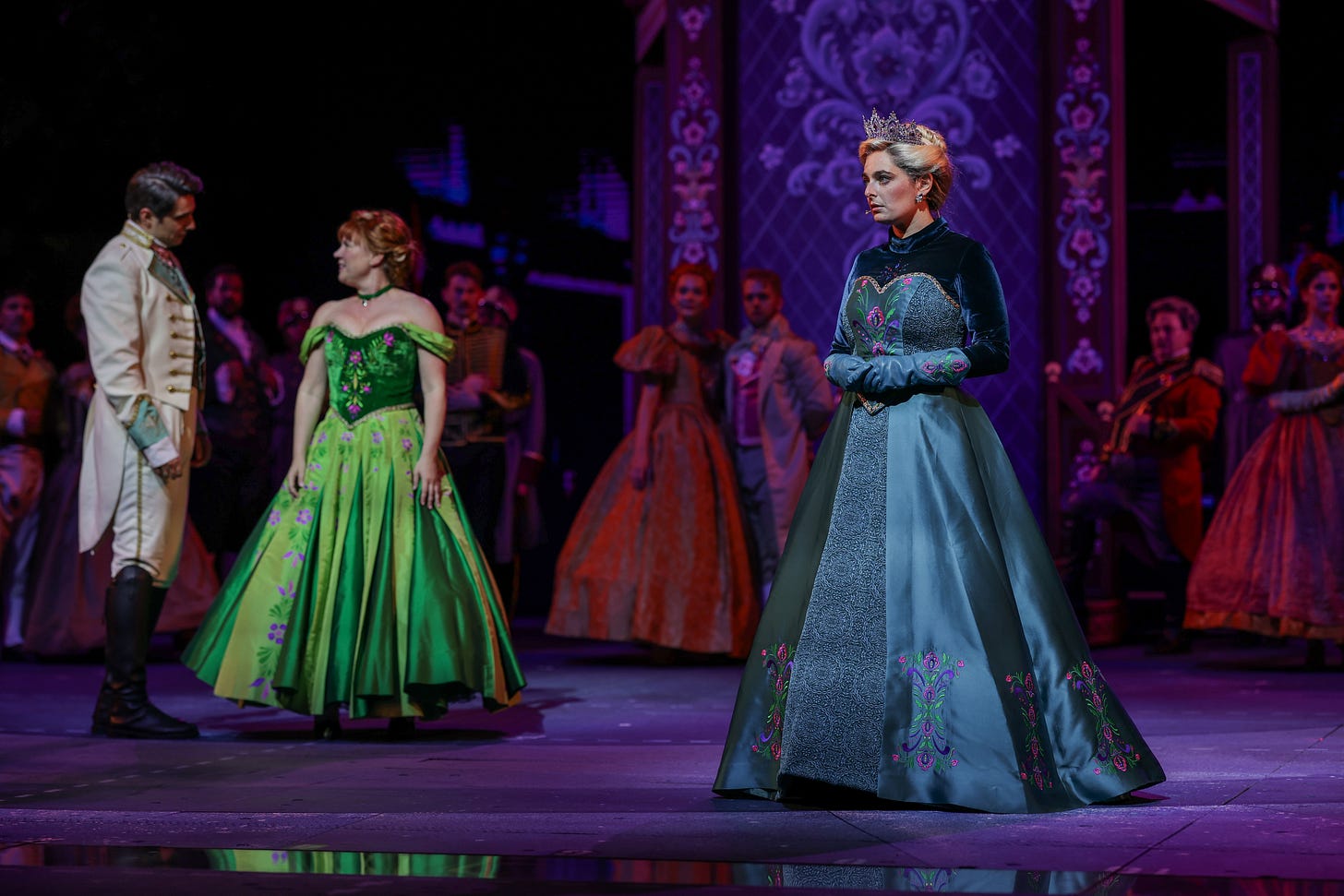Through July 14: A Dazzling Freeze Frame: The Muny’s “Frozen” Strikes a Perfect Balance of Spectacle and Heart
A historic leap forward in the Muny’s century-plus evolution
In an era when technological wizardry increasingly defines large-scale theatrical productions, the challenge lies in ensuring that spectacle doesn’t eclipse substance. With its premiere of “Frozen, “The Muny doesn’t just meet that challenge — it rewrites the playbook.
This production marks a historic leap forward in the Muny’s century-plus evolution, debuting cutting-edge digital mapping projections and high-powered lasers never before used on its stage. Designed over a two-year period by a visionary creative team — including lighting designer Jason Lyons, projection designer Kylee Loera and laser designer Rob Denton — these tools transform the James S. McDonnell Stage into a dynamic, immersive version of Arendelle.
Supported by four 40,000-lumen laser projectors and integrated with the Muny’s existing trio of LED walls, hand-painted booms, turntable and automation systems, the visual storytelling achieves something rarely seen in outdoor theater: it’s cinematic, fluid and responsive, yet never gimmicky or overwhelming. These dazzling effects — from swirling snow to shimmering magic — serve the story rather than overpower it.
And yet, as gobsmacking as this tech-driven spectacle is, it would mean little without a cast able to meet it beat for beat with warmth, humor, and heart. Fortunately, director John Tartaglia’s ensemble does exactly that, grounding the production in performances that feel just as human and resonant as the visuals are awe-inspiring.
This careful balance — between visual maximalism and emotional intimacy — is best exemplified by Hannah Corneau’s portrayal of Elsa. Corneau, luminous and restrained, resists the temptation to oversell the role’s iconic anthem. Her “Let It Go” emerges as the natural culmination of a young woman’s fear, grief and release, not as an expected showstopper. The Muny’s technological fireworks are at their most potent here, conjuring an ice castle from light and air, but it’s Corneau’s vocal and emotional precision that freezes the moment in memory.
As her younger sister Anna, Patti Murin brings a bounding energy and sharp comedic instinct to the stage. Murin’s Anna is neither caricature nor cloying; she’s resolutely likable, and the chemistry between her and Corneau gives real heft to the production’s central theme: that true love may reside not in romance but in sisterhood. Their duets, particularly “I Can’t Lose You,” are as musically rich as they are emotionally precise.
Jelani Remy, making a winning Muny debut as Kristoff, is delightfully unvarnished. His dynamic with Kennedy Kanagawa’s adorably exasperated Olaf and Andrew A. Cano’s wordless, expressive Sven adds a playful texture to Anna’s quest. Kanagawa accomplishes a deft sleight of hand—and voice—while operating Olaf. His fluid puppeteering is so attuned to gesture and timing that the mechanics all but vanish, leaving only Olaf’s endearing presence. That he manages to deliver full-bodied vocals while animating a character with such buoyant specificity is a quiet marvel of performance craft.
Bobby Conte’s Prince Hans, by contrast, simmers with polished charm that believably curdles into menace, especially in the latter half of the show. Conte’s tenor gleams in “Love Is an Open Door” but chills in the darker “Monster,” offering a reminder that Disney villains often sing some of the best material.
The younger versions of Anna and Elsa, played with poise and spark by Isla Turner and Maliah Strawbridge, help lay the emotional groundwork early on — their numbers are cleanly staged and earnestly performed, their youthful innocence setting the stakes for the narrative to come.
The ensemble, a robust mix of adults, teens and children, moves with cohesion and purpose through Patrick O’Neill’s choreography, which injects levity and rhythmic momentum without breaking the show’s emotional logic. The staging of the Hidden Folk — a mossy replacement of the film’s rock trolls — adds a folkloric, Caliban-ish strangeness.
In a production where virtually every scene contains a visual flourish, what lingers most is the deep-seated feeling that this “Frozen” is more than just an achievement of stagecraft – it is an argument for theater’s capacity to dazzle and disarm simultaneously. It’s as much a technical marvel as it is a love letter to the emotional durability of the story — and to audiences willing to believe in snow, even in the height of a St. Louis summer.
The Muny’s production of “Frozen” runs July 6-14 in Forest Park. For more information, visit their website.







